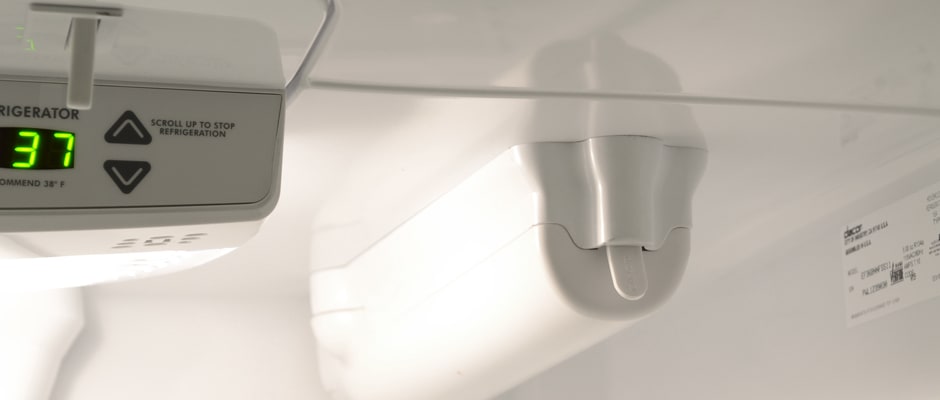Introduction
That said, this counter-depth model can offer consumers some of the best overall performance that we've seen of late, good enough that it may very well make the fridge worth the investment. This model was designed a couple of years ago, and consumers can use that to their advantage: typical sale prices drop down to about $2,699, but sometimes patience pays off, especially for consumers who want a French door counter-depth and care more about substance than style.
Front
{{section_header}}{{section.name}}{{/section_header}}
This particular {{product.brand.name}} has a traditional stainless steel finish. The French door format is unaltered, with two doors on top accessing the fridge and a pull-out freezer on the bottom.
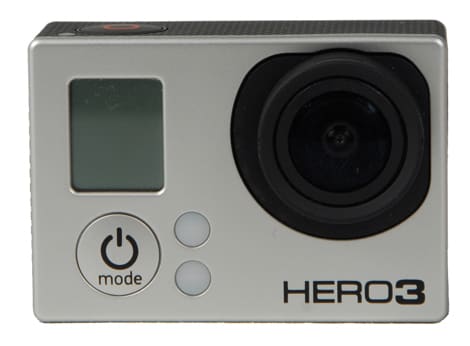
As with all stainless appliances, this {{product.brand.name}} suffers from a weakness to fingerprints. Smudging will abound, especially if you've got a house full of little kids.

Controls for this model are located at the top of the fridge interior, something we never expected to see on a refrigerator that costs this much. At the very least, the thermostats still manage to use actual degrees instead of an arbitrary scale. Everything on this fridge is controlled from the main panel except for the ice maker; that is managed using an old-fashioned wire switch attached to the ice maker itself.

You can imagine our surprise when, upon unpacking this fridge, we discovered that it came without any handles! After investigating online at the Dacor website, it seems that the handles for this particular model are sold separately. On one hand...really? On the other hand, it also seems that there are different types of handles to choose from, so you can get whichever set best suits your personal taste.

While the ice maker is located inside the freezer compartment (we'll get to that a little farther down), the water dispenser is actually found in the fridge interior. A little spout protrudes from the left-hand wall near the front, just a few inches above the crisper drawers. The device is activated by pressing a grey padded button located immediately above the actual spout. There's no cavity here, and the dispenser is set in front of any shelf or drawer, so you have no choice but to hold your glass while it's filling.

Interior
{{section_header}}{{section.name}}{{/section_header}}
Glass shelves with plastic trim in the fridge and wire shelves in the freezer feel cheap and clunky. With a bulky interior light, traditional light bulbs, and even a visible water tank, this fridge's design screams mid-range.
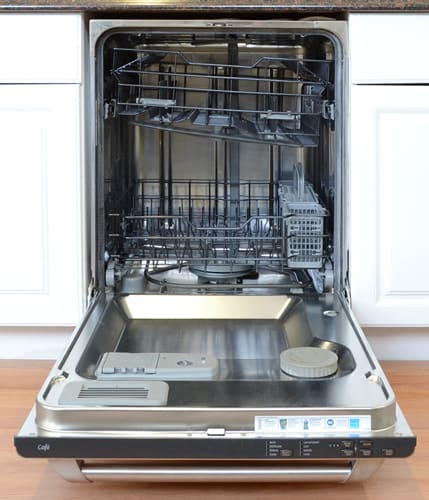
The interior of the CDWT980VSS.
The layout of the main fridge cavity is pretty much run-of-the-mill. There are four half-width adjustable shelves which mount to the back using hooks. The shelves can all slide forward, granting you easy access to items in the back. A full-width, fixed shelf sits below these, with two crispers drawers underneath that. At the very bottom is a full-width drawer—albeit one without its own temperature control—for additional storage space.
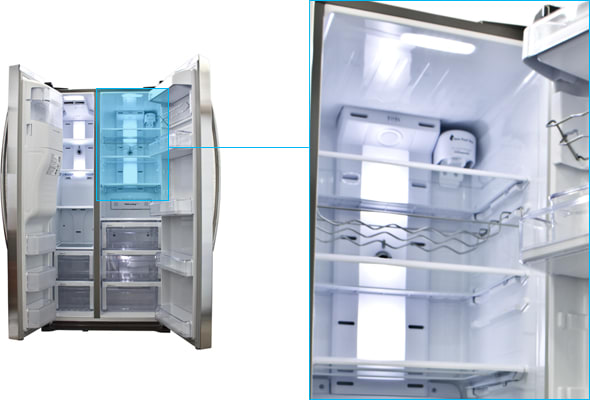
As we've seen many times before, the water filter is located in the upper right-hand corner of the fridge. It's easily accessible, and as long as you don't stack tons of items up underneath it, you should be able to change the actual filter without too much of a problem.
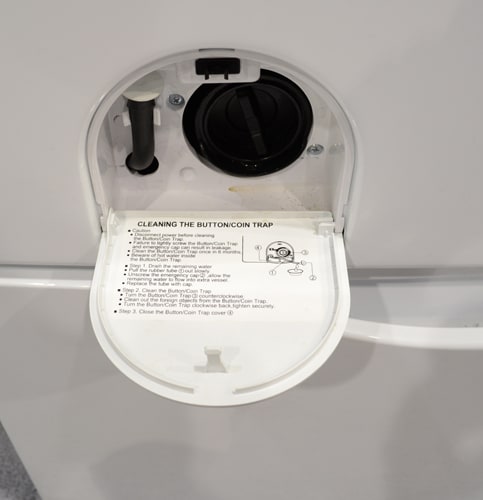
The left-hand door holds three regular bucket shelves. Only the top two are adjustable; if you tried to squeeze the third one up there, they'd be too close together to be of any practical use.
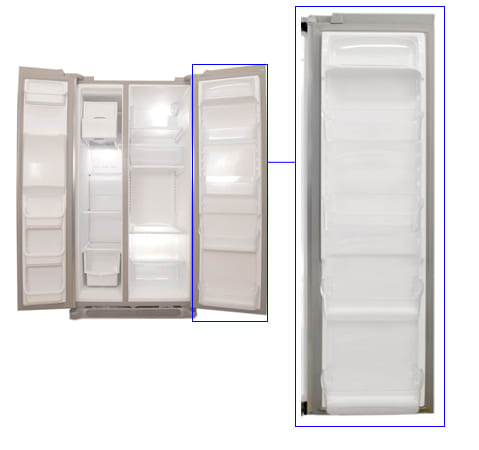
The right-hand door has two shelves—though only enough space to adjust one of them—and a designated dairy bin at the top.
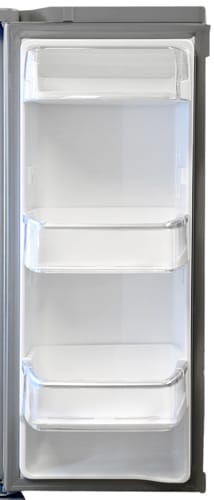
The door bins here are quite large, holding up to two gallons and four water bottles each.
All of the shelves except the dairy bin have removable rubber inlays. They're easy to take out, and provide an alternative approach to keeping the plastic on the bottom clean, as well as preventing loose items from sliding around.

The rubber linings help keep things clean and in place.
Since this is a counter-depth fridge, there's not much leeway for the freezer to get too creative. There are two main storage areas, both of which are made out of wire. The upper shelf has a left portion—slightly narrower—and a right portion; there's an ice bucket which fits into the left portion, under the ice maker. Under this is the main storage bucket, which is also divided. The lower portion is split evenly, though, for matching left and right halves.
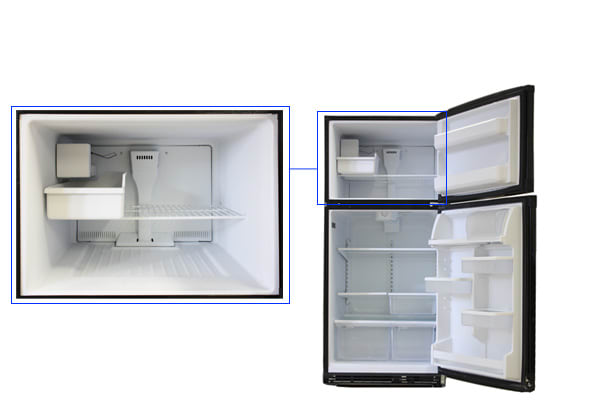
The old-fashioned ice maker is found inside the freezer compartment in the upper left-hand corner. You turn it on or off by flipping the large wire switch. Since the freezer itself is so shallow, the ice maker—and, as such, the switch that activates it—is fairly close to the front.
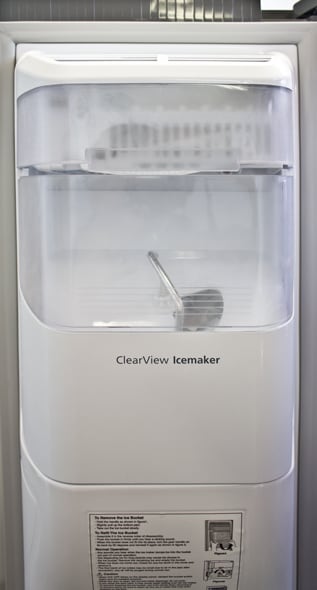
Back
{{section_header}}{{section.name}}{{/section_header}}
Nothing terribly exciting on the back. Just a couple of tubes for water transit and a power cable.
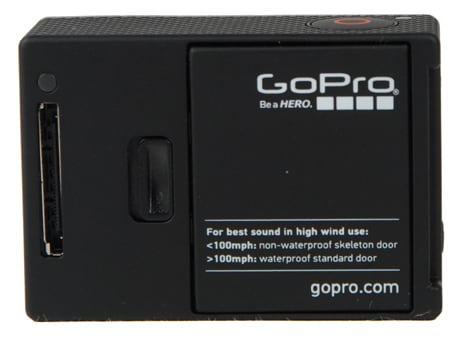
Sides
{{section_header}}{{section.name}}{{/section_header}}
The matte sides are colored grey, giving the fridge a uniform appearance. You may notice that the side view seems unusually narrow; that's because this fridge is designed to line up with the edge of shorter kitchen counters, giving the room a smooth, flush appearance.
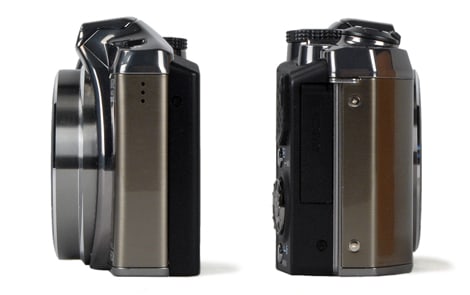
Olympus SZ-31MR iHS side views
Running Cost
{{section_header}}{{section.name}}{{/section_header}}
Large fridges, even counter depth ones, tend to run up a hefty electric bill. Not so with the {{product.brand.name}}. Using a standard rate of $0.09 per kW-h, this fridge should only cost you about $27.15 per year to operate. Running the ice maker and water filter may raise that a bit, but either way, that number would be low for even smaller models.
Power Use Per Cu Ft
{{section_header}}{{section.name}}{{/section_header}}
In order to balance the potential discrepancies in energy consumption for fridges of different size, we look at how much energy is used per cubic foot of usable space. This counter depth fridge isn't terribly big, but even so, it only uses 0.07 kW-h per cubic foot. That's exceptional, definitely on the low end of energy use.
Fridge Temperature
{{section_header}}{{section.name}}{{/section_header}}
On one hand, our temperature sensors in the fridge interior didn't provide readings that matched the 37 degrees listed on the thermostat. On the other hand...they were actually lower! Temperatures from top to bottom in this particular model all stayed within one degree, with an average of 35.6 degrees throughout. Fluctuation over time was only a quarter of a degree in all sections, too. This is absolutely fantastic temperature consistency, some of the best we've seen. While we're not a fan of temperatures that don't match the settings, we certainly don't mind it doing a better job than we expected.
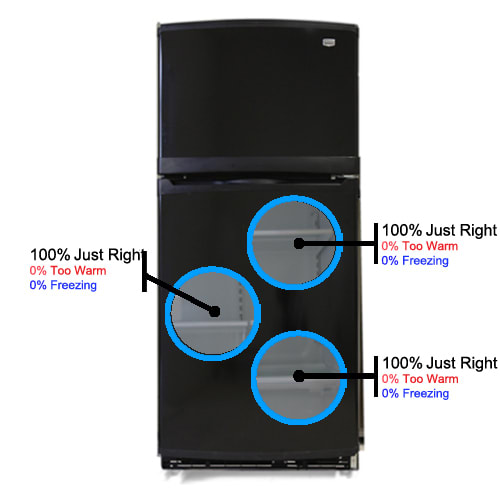
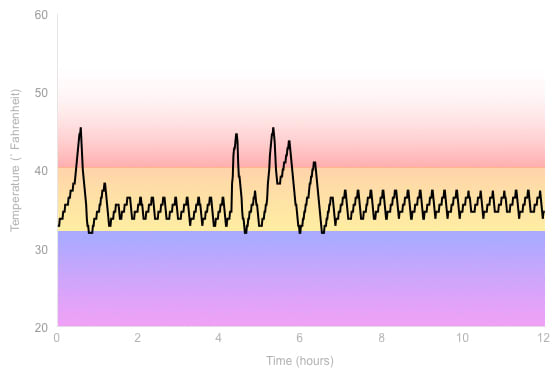
Freezer Temperature
{{section_header}}{{section.name}}{{/section_header}}
The freezer did an excellent job, though not quite as thoroughly as the fridge compartment. Our sensors picked up average temperatures of just under one degree Fahrenheit, with the top of the freezer running slightly cooler than the bottom. Fluctuation over time stayed within about a third of a degree, which means that the risk of freezer burn in this compartment is satisfyingly low.
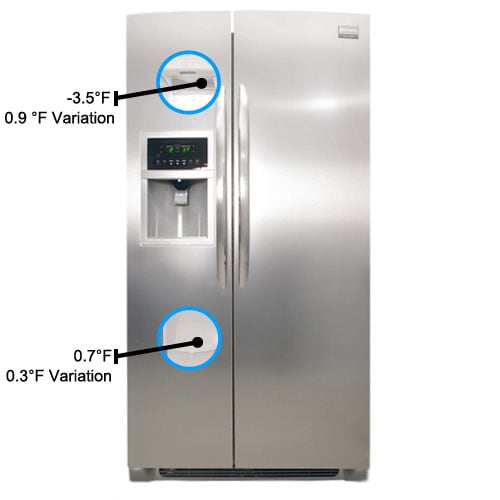
Vegetable Drawer
{{section_header}}{{section.name}}{{/section_header}}
Over the course of three days, the test materials that were placed in the {{product.brand.name}}'s vegetable drawer lost an average of 0.17 grams of moisture per hour. While not the absolute best we've ever seen, this is nevertheless an excellent—and perfectly acceptable—level of performance. Vegetables kept in here should stay fresh and crisp for slightly longer than average, though they will still go bad eventually.
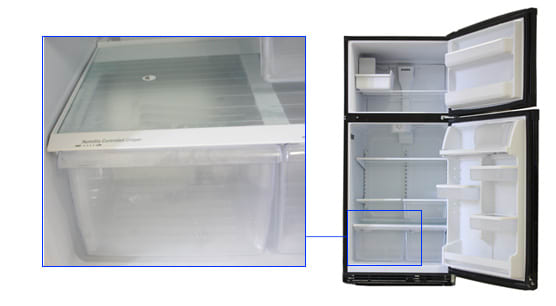
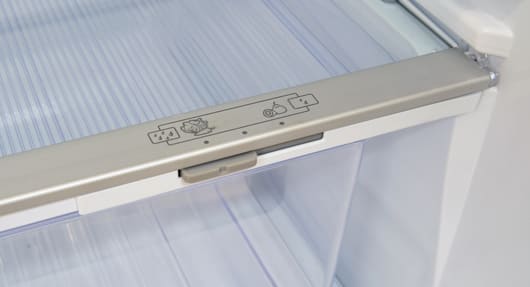
Power Loss
{{section_header}}{{section.name}}{{/section_header}}
To simulate a power outage (something appliance manufacturers may want to do more of given the crazy weather over the past few months), we simply unplug the fridge after all other tests have been completed. After 36 hours, temperature sensors indicated that the freezer's internal temperature had increased to just 28 degrees. Everything was still thoroughly frozen, though we have to mention the small caveat that we never opened the freezer door during this time.
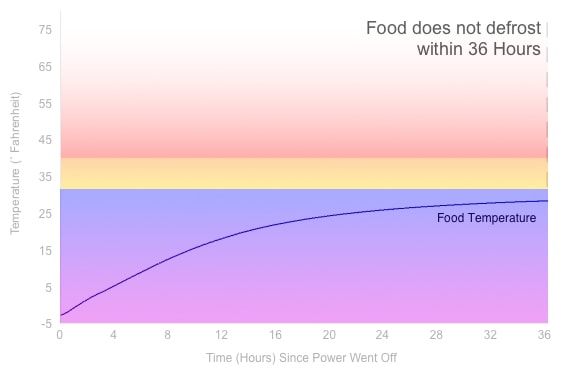
Freezing Performance
{{section_header}}{{section.name}}{{/section_header}}
Perhaps the most average test result exhibited by the {{product.brand.name}}, it took one hour and 36 minutes for our room-temperature test materials to freeze. This isn't great, but it's certainly not bad, either. If fantastic freezing times are just over an hour, and some of the worst take a little over two, this model falls smack dab in the middle.

Usable Space
{{section_header}}{{section.name}}{{/section_header}}
Four half-width shelves, a full-width shelf, two crisper drawers, and a full-width drawer at the bottom provide a variety of storage areas for your groceries. The catch with the {{product.brand.name}}, however, is that it's a counter-depth fridge. Counter-depths, by their very nature, are shallower than their full-sized counterparts. Taking into account the not-insignificant amount space taken up by things such as the light fixture and the water filter, we determined that the {{product.brand.name}}'s fridge cavity can hold a total of 8.99 cubic feet worth of items. It's not bad for a counter-depth, but still can't hold up against the larger models on the market.
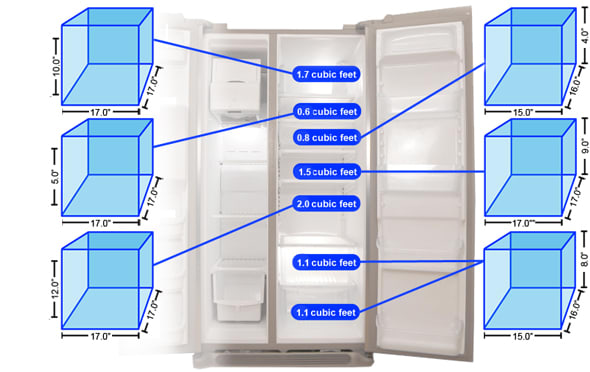
Three fairly shallow bucket shelves provide additional storage on the left-hand door.
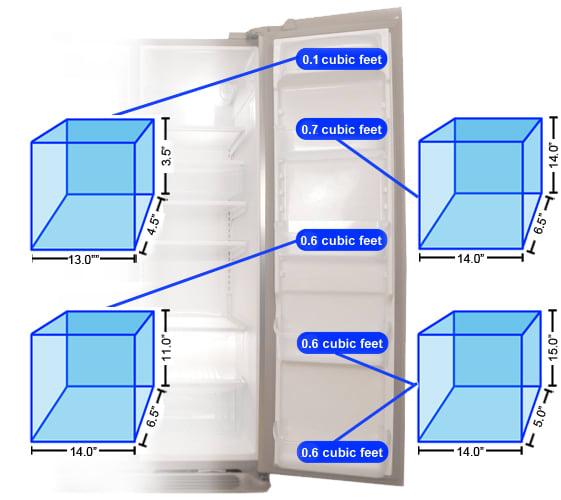
The dairy bin and two other shelves on the right-hand door also contribute. The storage space found on both doors is included in the aforementioned total.
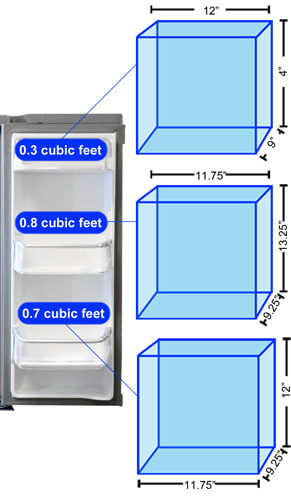
The shallow, short freezer compartment looks small...and, unfortunately, looks are not deceiving in this case. The top drawer and bottom section, each divided into a left and right portion, total a meager 2.7 cubic feet of usable space. A large portion is taken up by the ice maker and its wire switch. You might as well use it, since you're going to lose a good chunk of space to it either way.
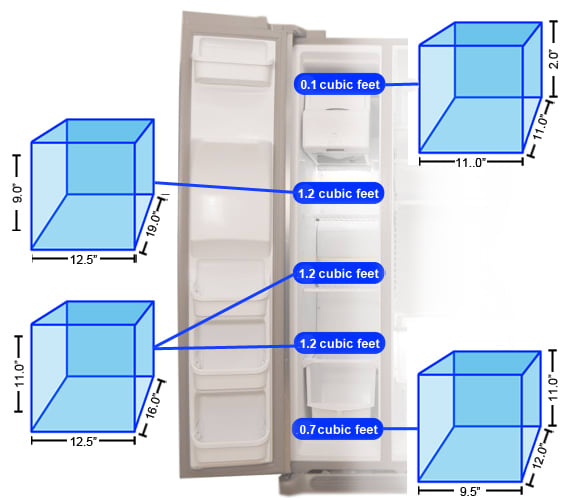
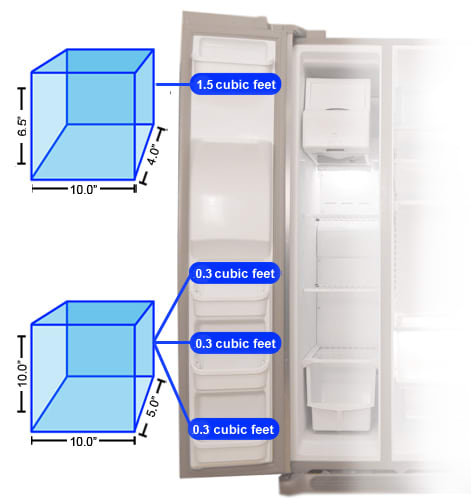
Below are the manufacturers own figures for capacity, and our own measurements for usable capacity. The manufacturers figures do not take account of the shelves, drawers and other removable features, but our measurements do account for the space these take up.
Ease of Access
{{section_header}}{{section.name}}{{/section_header}}
The two different compartments have two very disparate levels of user access. The fridge employs shelves that slide out and plenty of open spaces, making food access a breeze. Since this is a counter-depth model, though, the pull-out freezer door doesn't extend that far. Bending down to get into bottom freezers is already difficult; the fact that this narrow space makes it harder to get your arms in is just an added nuisance.
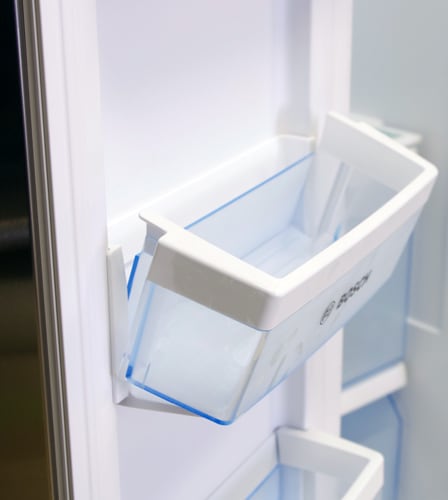
Controls
{{section_header}}{{section.name}}{{/section_header}}
Controls for this model are located at the top of the fridge interior, something we never expected to see on a refrigerator that costs this much. At the very least, the thermostats still manage to use actual degrees instead of an arbitrary scale. Everything on this fridge is controlled from the main panel except for the ice maker; that is managed using an old-fashioned wire switch attached to the ice maker itself.
Internal controls are never really approved of on high-end fridges, but at least the manufacturers have done a decent job designing them. Despite not having actual buttons to press—they're really just markings on a plastic covering—the controls are actually quite responsive. As long as you can reach them, getting this fridge to work according to your desires shouldn't be at all difficult.

Water Dispenser
{{section_header}}{{section.name}}{{/section_header}}
While opening the fridge door to get at the water dispenser is a little convenient (not to mention a small waste of energy), the dispenser itself is very easy to use. You hold a cup under the spout, push the button, and out comes the water. It's low-tech, low-brow, and gets the job done.

Ice Maker
{{section_header}}{{section.name}}{{/section_header}}
The old-fashioned ice maker is found inside the freezer compartment in the upper left-hand corner. You turn it on or off by flipping the large wire switch. Since the freezer itself is so shallow, the ice maker—and, as such, the switch that activates it—is fairly close to the front.

Cleaning
Noise
Other Features
{{section_header}}{{section.name}}{{/section_header}}
{{product.manufacturer_specs['Other Features Photo BROKEN?']}}
Conclusion
Energy Efficiency
The fridge is exceptionally energy efficient, one of the best we've seen. We're not going to speculate as to why, but we do know that this fridge is definitely going to save you some money in the long run. (Perhaps you can use those savings to buy the handles that aren't included.)
Performance
We found excellent temperature control throughout the entire appliance. Moisture retention is solid, and freezing times weren't that bad, either.
Storage Space
Counter-depths aren't designed to be incredibly spacious; you need a full-sized fridge to really accommodate extended family during the holiday season. That said, the {{product.brand.name}}'s fridge is still pretty roomy, though the freezer is incredibly cramped and won't hold all that much.
Usability
Controls, the water dispenser, and the ice maker are all found on the inside of the fridge (usually the mark of a mid-range product). Even so, everything is fairly accessible and easy to clean—except for the troublesome pull-out freezer—and each separate component of the fridge is straightforward and simple to use.
Meet the tester
Matthew is a native of Brockton, MA and a graduate of Northeastern, where he earned a degree in English and Theatre. He has also studied at the Gaiety School of Acting in Dublin and spends most of his free time pursuing a performance career in the greater Boston area.
Checking our work.
Our team is here to help you buy the best stuff and love what you own. Our writers, editors, and experts obsess over the products we cover to make sure you're confident and satisfied. Have a different opinion about something we recommend? Email us and we'll compare notes.
Shoot us an email
